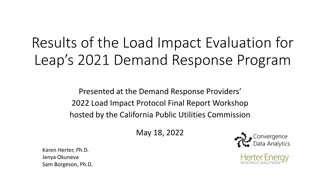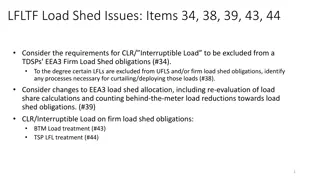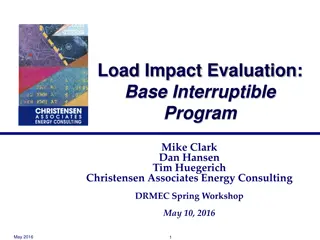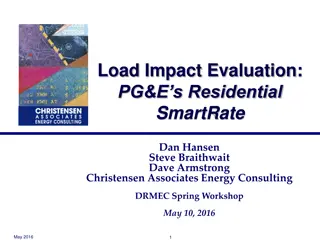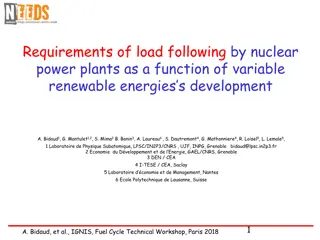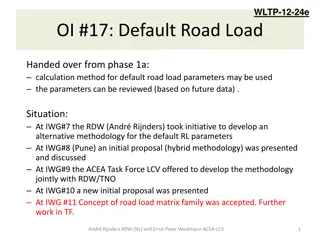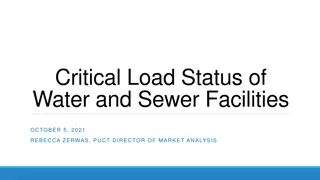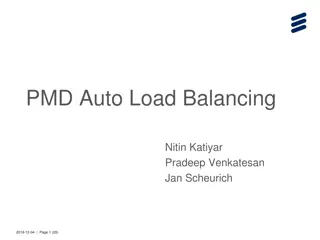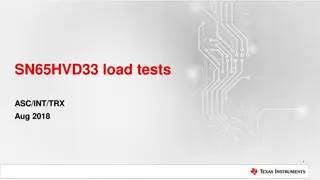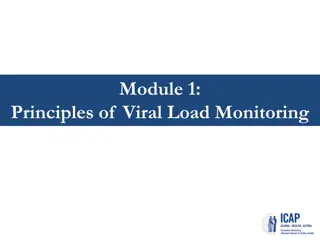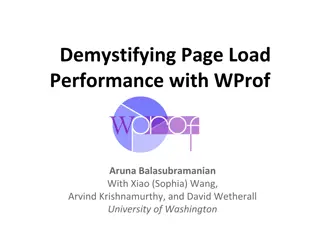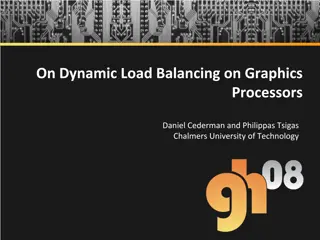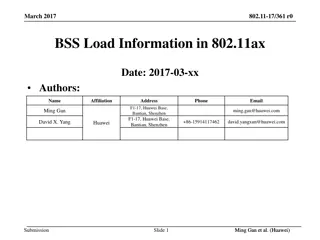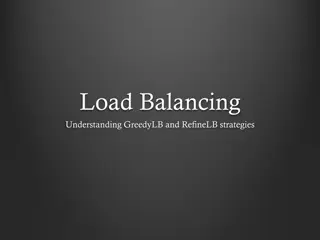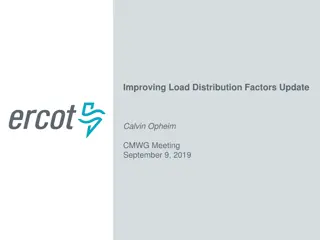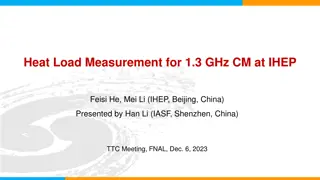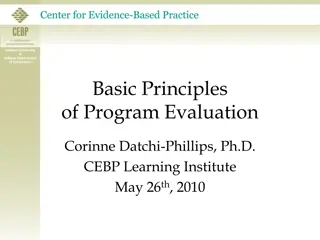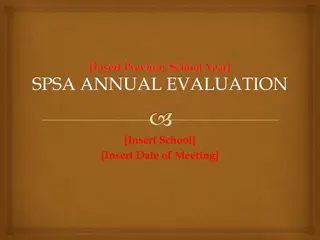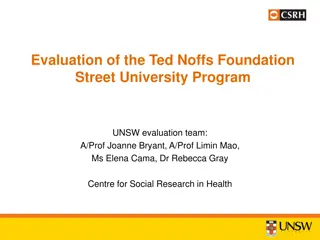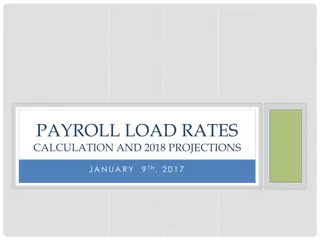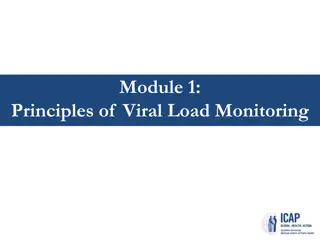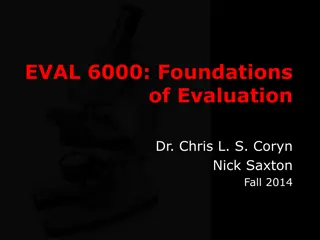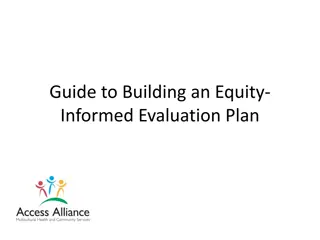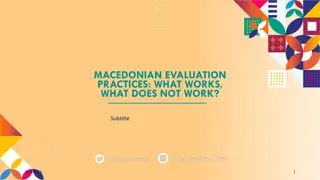PG&E's SmartACTM Program Load Impact Evaluation
Understanding the load impact evaluation of PG&E's SmartACTM Program presented by Xueting (Sherry) Wang at the DRMEC Spring Workshop in May 2022. The presentation outlines the program description, ex-post and ex-ante methodologies, enrollment forecasts, load impacts, and recommendations based on the findings.
Download Presentation

Please find below an Image/Link to download the presentation.
The content on the website is provided AS IS for your information and personal use only. It may not be sold, licensed, or shared on other websites without obtaining consent from the author. Download presentation by click this link. If you encounter any issues during the download, it is possible that the publisher has removed the file from their server.
E N D
Presentation Transcript
Load Impact Evaluation: PG&E s SmartACTMProgram Xueting (Sherry) Wang Corey Lott Christensen Associates Energy Consulting DRMEC Spring Workshop May 3-4, 2022 1
Presentation Outline 1. Program Description 2. Ex-post Methodology 3. Ex-post Load Impacts 4. Ex-ante Methodology 5. Enrollment Forecast 6. Ex-ante Load Impacts 7. Recommendations 2
1. SmartACTM Program Description Direct load control AC cycling program for residential customers Participants receive one-time incentive, can opt-out of events SmartAC integrated into CAISO wholesale market in PY2018 Events up to 6 hours per day (May October) Sub-LAP Events: all customers within a sub-LAP called Serial Number Events: random sample of full territory 83,000 enrolled (May 2021), 8,000 dually enrolled SmartRate The CPUC approved swap out of all remaining one-way devices for two-way devices by 2024 (D.21-12-015) 3
2. Ex-post Methodology For sub-LAP events: matched control group + difference-in- differences Two-Stages of Matching: 1) 3-to-1 matching using all potential control customers Nearest neighbor matching on average monthly usage, weather station, CDD60, CARE, NEM, dwelling type, AC usage level, rate schedule 2) 1-to-1 matching on selected controls from first stage Propensity score matching using interval load data for non-event day loads, CARE, NEM, dwelling type, and AC usage level Matches segmented by sub-LAP Two 24-hour average load profiles used for matching: hot days (top 10%) and a selection of cooler days (25th to 50th percentile) For serial event on 7/9 Sub-LAPs with double events same method as sub-LAP events Serial event only sub-LAPs: withheld serial group 0 serves as control 4
3. Ex-post Load Impacts: Events Smart- RateTM Event? Event Hours (p.m.) # Sub-LAPs/Serial Groups Dispatched Date Reason Customers Dispatched Market Market 4:00-7:00 PGNP, PGNC, PGEB 5:00-8:00 PGSI, PGST, PGF1 PGNP, PGSI, PGST, PGKN, PGF1, PGZP, PGNC 5:00-7:00 PGNP, PGKN, PGF1, PGZP 4:00-7:00 PGSI 4:00-6:00 PGNP, PGST 4:00-6:45 PGNP, PGKN, PGF1, PGZP All Sub-LAPs, Serial Group 0 withheld PGNP, PGSI, PGST, PGKN, PGF1, PGZP, PGNC PGNP, PGSI, PGKN, PGF1, PGZP, PGNC 29,119 33,004 6/17 No 6/18 No Market 5:00-8:00 51,053 6/19 6/26 6/27 No No No Yes Market Market Market Market 31,503 13,100 17,653 26,957 7/9 No Emergency 6:50-9:16 62,477 7/10 Yes Market 5:00-8:00 44,233 7/11 No Market 5:00-8:00 44,923 5
3. Ex-post Load Impacts Average Event-Hour Load Impacts by Event Overall: 0.23 - 0.42 kWh/customer/ hour Drivers of variation: sub-LAPs called, event temperatures, hours of the day Serial event load impact lower than previous years (low temperature for many sub-LAPs, late hours, 2 events in a row for 4 sub-LAPs) 6
3.Ex-post Load Impacts Hourly Load Impacts for sub-LAP event on June 18, 2021 51,053 customers called 5-8 p.m. Peak of 23.4 MWh/hour during hour 2 of event (6-7 p.m.) Average per- customer load impact 0.42 kWh/customer/hr 7
3.Ex-post Load Impacts PY2020 vs. PY2021 About 6,500 fewer customers were dispatched (Program attrition) Comparable average load impact despite higher temperature (lower performance due to aging devices) Average reference load is lower in PY2021 despite higher temperature (diminished shelter- in-place effect) Reference (kW/cust) Load Impact (kW/cust) Avg Temp ( F) Avg. # called sub-LAP PY2020 242 18,477 16,808 14,966 13,953 1,817 4,586 1,328 626 12,970 11,775 3,384 7,546 14,355 13,104 6,516 1,873 74,369 67,792 PY2021 PY2020 PY2021 PY2020 PY2021 PY2020 PY2021 1.77 0.30 3.36 2.97 0.53 3.34 3.50 0.34 2.44 0.35 4,050 3.39 3.65 0.35 3.05 0.49 515 2.72 2.86 0.32 3.32 2.91 0.44 2.86 0.46 2.31 0.38 3.02 3.13 0.37 5,900 3.34 3.21 0.50 1,687 3.27 3.04 0.21 3.27 3.16 0.42 PGCC PGEB PGF1 PGFG PGKN PGNB PGNC PGNP PGP2 PGSB PGSI PGST PGZP Common Sub-LAPs 56.0 103.9 103.9 95.1 103.8 100.7 98.4 104.0 96.0 94.3 101.9 102.1 102.8 0.52 0.37 107.3 107.9 0.42 110.5 0.34 0.31 98.2 102.9 0.43 0.44 0.21 0.41 103.31 105.47 103.9 101.5 101.0 Comparable Load Impact Higher Load Impact in 2021 Lower Load Impact in 2021 8
3.Ex-post Load Impacts PY2020 Ex-Ante vs. PY2021 Ex-Post Load Impact (kW/cust) Load Impact (MW) Avg. Temp ( F) Full Event Hours (p.m.) # # Forecast Enrollment in LCA in 2022 Called in LCA PY2021 Enrolled in LCA PY2021 Date Ex- Post 0.44 0.41 0.30 0.28 0.23 0.35 0.42 0.32 Ex- Ante 0.38 27.5 0.32 20.8 0.32 0.29 0.43 0.41 0.38 18.5 0.36 14.4 Ex- Post Ex- Ante 29.2 104.9 101.0 17.3 106.0 101.0 10.0 104.8 103.4 3.7 97.8 100.6 8.7 91.9 102.9 12.8 107.6 106.4 20.3 107.2 102.8 17.0 103.4 102.8 Ex- Post Ex- Ante 6/17 6/18 6/19 6/26 6/27 7/9 7/10 7/11 5-7 5-8 5-7 4-7 4-6 4-6 5-8 5-8 62,123 77,059 51,053 53,846 31,503 31,503 13,100 13,100 17,653 19,339 26,957 26,957 44,233 46,858 44,923 47,701 76,111 53,961 31,420 13,082 20,313 31,112 53,428 47,278 9.5 3.7 4.0 9.5 Lower Load Impact and Higher Temperature in 2021 Higher Load Impact and Higher Temperature in 2021 Lower Load Impact and Lower Temperature in 2021 Limitations: ex-post are sub-LAP events while ex-ante forecast at LCA level Most differences in per-customer load impacts explained by temperature differences 9
3.Ex-post Load Impacts: Device Type Average Event-Hour Load Impacts by Device Type across Sub-LAP Events Average Event Hour Device Type Avg. # Dispatched Avg. # Enrolled Aggregate Impact (MW) Avg. Temp ( F) Reference (kW/Cust) Impact (kW/Cust) % Impact 1-Way 30,225 68,132 3.14 0.34 10.7% 10.18 104.8 2-Way 6,208 10,810 3.53 0.59 16.7% 3.66 106.6 Two-way devices have higher per customer and percent load impacts than one-way devices Only 14 percent of SmartAC during PY2021 Swap-out of one-way devices in 2022-2023 will improve SmartAC program performance Reference loads are higher for two-way device customers (previous device swap-outs targeted high AC users in hotter regions) customers had two-way devices 10
4. Ex-ante Methodology Forecast methodology accounts for device swap-outs Ex-ante forecast incorporates device swap-outs (PG&E assumptions) Swap-outs completed by 2024 Separate load impact estimates for one-way and two-way devices Increased marketing efforts to counteract annual program attrition 10.6 percent attrition 7,000 new customers Overall 1 percent increase 11
4. Ex-ante Methodology (2) Per customer load impacts were developed separately for one-way and two-way devices using: Parameters obtained from regressions of per-customer load impacts as a function of weather, hour, sub-LAP and serial event indicator Ex-ante weather data and day-type characteristics (e.g., temperatures on a CAISO 1-in-2 August peak day) Load impacts by device-type are combined based on the relative share of two-way devices reflected in the enrollment forecast from PG&E Reference loads were developed for each month, sub-LAP, and enrollment segment (SmartAC-only and dually enrolled) using: Non-event days: Non-holiday weekdays Parameters obtained from regressions of per-customer hourly usage as a function of weather (CDD60) and load shape variables Ex-ante weather data and day-type characteristics 12
5. Enrollment Forecast Enrollment Forecast by LCA (2022-2032) Enrollments decline in 2022 and increase by the end of 2022 (increased marketing efforts) Assume 20,000 customers with one-way devices will be de-enrolled in January 2024 (share of customers that do not consent to device swap-out) Enrollments increase by 1 percent per year between 2024 and 2032. Heterogeneity across LCAs (increases in Central Valley areas) 13
6. Ex-ante Load Impacts Aggregate Load Impacts by LCA, Average Event Hour (4-9 p.m.) PG&E 1-in-2 July Peak Scenario (2022-2032) Aggregate load impacts increase from July 2022 to 2023 (4,000 additional customers, two-way devices) Aggregate load impacts decrease from July 2023 to 2024 (20,000 customers de-enrolled) Aggregate load impacts increase from 2024 to 2032 (increased marketing efforts) 14
6. Ex-ante Load Impacts 2024 Aggregate Hourly Loads and Load Impacts for PG&E 1-in-2 July Peak Day: All SmartAC customers Aggregate load impacts peak in the first hour of the resource adequacy (RA) window Average RA window load impact: 25.4 MWh/hour Percent Load Impact: 16% of reference load 15
6. Ex-ante Load Impacts PY2021 Ex-Post vs. PY2021 Ex-Ante PY2021 Sub-LAP Event Load Impacts PY2021 Forecast Level Outcome 1-Way 2-Way 57,263 10,507 67,770 63,882 53,215 177.5 36.9 214.4 22.0 6.1 28.1 105.3 106.6 105.5 12.4% 16.6% 13.1% 3.10 3.51 3.16 0.38 0.58 0.41 All 2022 2024 Enrollments Reference (MW) Load Impact (MW) Avg. Temp ( F) % Load Impact Reference (kW) Load Impact (kW) 202.4 32.0 103.8 15.8% 3.17 0.50 172.3 32.6 103.9 18.9% 3.24 0.61 Total Per Participant Compare ex-post load impacts with PG&E 1-in-10 scenario Use ex-ante results for the eight sub-LAPs that were called for sub-LAP events in 2021 Higher per-customer load impacts in 2022 and 2024 due to device swap-outs and shift in customer composition to Central Valley 16
6. Ex-ante Load Impacts PY2020 vs. PY2021 July Peak 2022 PY2020 70,222 181.7 18.1 97.7 10.0% 2.59 0.26 July Peak 2024 PY2020 55,372 140.6 14.0 97.7 10.0% 2.54 0.25 Level Outcome PY2021 75,817 187.7 25.0 98.4 13.3% 2.48 0.33 PY2021 60,274 155.8 25.4 99.1 16.3% 2.58 0.42 Enrollments Reference (MW) Load Impact (MW) Avg. Temp ( F) % Load Impact Reference (kW) Load Impact (kW) Total Per Participant Per-customer and percent load impacts are higher in PY2021 forecast due to device swap-outs and shifts of enrollments to hotter regions Increased enrollments leads to higher aggregate load impacts in 2022 and 2024 compared to previous forecast 17
7. Recommendations Continue to have some system-wide or serial events called in isolation going forward for the purpose of load impact estimation Dispatch events over a variety of temperatures to produce more robust forecast models 18
Questions? Contact Corey Lott: cjlott@caenergy.com Sherry Wang: swang@caenergy.com Dan Hansen: dghansen@caenergy.com Christensen Associates Energy Consulting Madison, Wisconsin 608-231-2266 19



